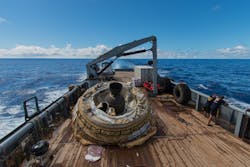NASA Explores Supersonic Decelerators for Martian Landings
NASA engineers are developing testing new devices that will work together to land large (greater than 1 ton) payloads on Mars, including robotic rovers and the equipment and supplies for a manned exploration of the Martian surface. The goal is to slow spacecraft from Mach 3.5 or more to a subsonic speed that will let spacecraft land safely and accurately in areas NASA wants to explore. NASA also wants a landing technique that does not call for large amounts of extra rocket propellant or heavy atmospheric shielding. The challenge is that Mars lacks Earth’s dense atmosphere, so conventional aerodynamic braking and parachutes won’t work. And the Martian atmosphere is too thin for NASA to rely solely on rockets and thrusters as it did for its lunar landers.
To slow capsules from Mach 3.5 to 2, NASA has developed two versions of supersonic inflatable aerodynamic decelerators (SIAD). These rugged donut-shaped devices inflate around the capsule or spacecraft to boost its drag and, thus, slow it down. The SIAD-R measures 20 ft in diameter and is designed to take future rovers and other robotic missions down toward the Martian surface. Pressurized hot gases will inflate it. The SIAD-E, sized for missions related to manned flights to Mars, is 26 ft in diameter and inflates using ram air pressure.
Once the capsule slows to Mach 2, a parachute can deploy to slow it to subsonic speeds. This all-new, 110-ft-diameter disc-sail parachute will have twice the area of the parachute used to land the Curiosity rover. (The Curiosity parachute was closely based on the one that landed the Viking spacecraft on Mars almost 40 years ago.)
NASA cannot test these new devices on Mars, so it will rely on wind-tunnel and rocket-sled testing, as well as stratospheric drops from rockets or balloons. On some of the drops, NASA plans to add thrusters that will ensure the devices fall and are tested at supersonic speeds.
